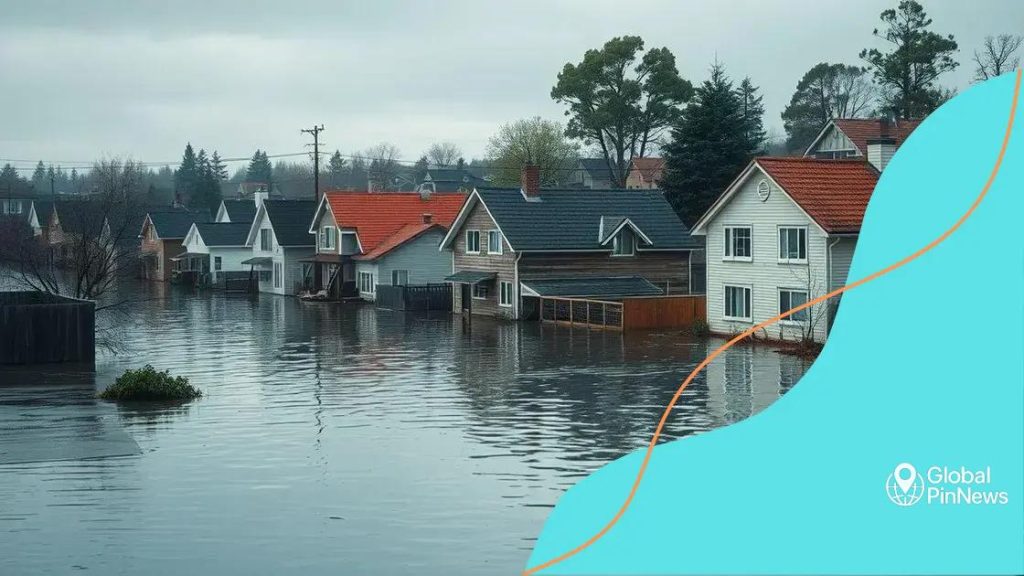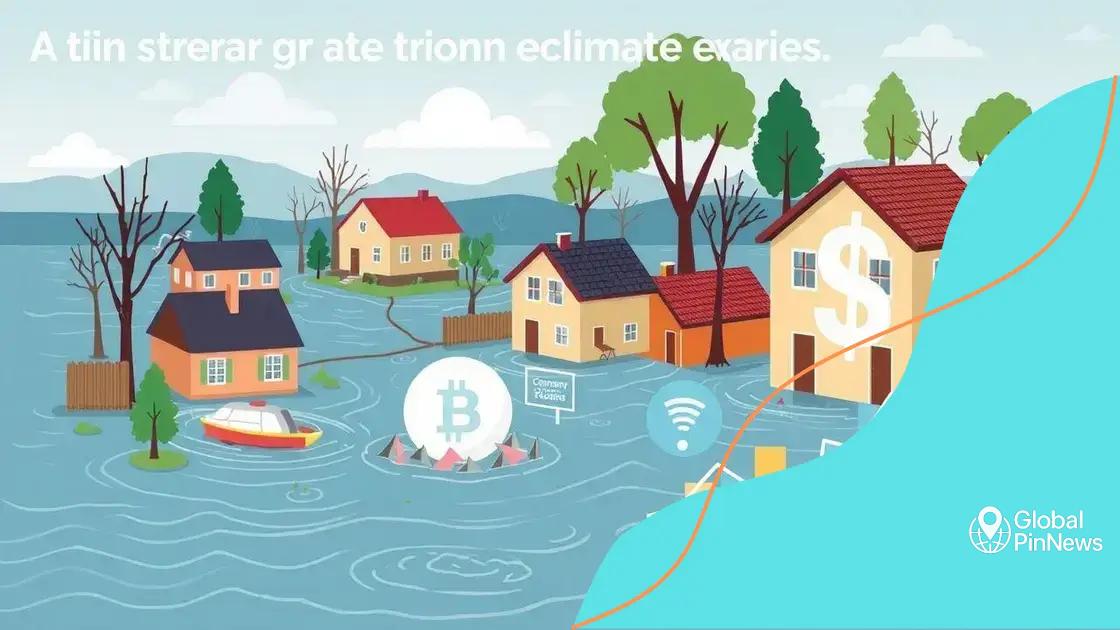Impact of recent climate events in the US: what you need to know

The impact of recent climate events in the US significantly disrupts communities through increased extreme weather, economic challenges, and urgent adaptation needs, necessitating collective action and innovative solutions for resilience.
Impact of recent climate events in the US has been significant, reshaping landscapes and communities. Have you noticed how these changes affect daily life? Let’s dive into the details.
Overview of recent climate events
The overview of recent climate events highlights a significant shift in weather patterns across the United States. These changes have become more pronounced, demonstrating the impacts of climate change. Understanding these events is crucial for everyone.
Key Climate Events
Some notable climate events have recently occurred. These instances serve as reminders of the challenges that communities face.
- Hurricanes: Increased intensity and frequency have been observed.
- Wildfires: Areas like California are experiencing longer fire seasons.
- Flooding: Rising sea levels contribute to severe floods.
These climate events affect us in many ways. For instance, wildlife habitats are being altered, which changes ecosystems. Additionally, our health is impacted due to increasing heatwaves and poor air quality.
Shifting Weather Patterns
Weather patterns are changing as well. We see higher temperatures in many regions, while others experience unexpected cold spells. This unpredictability makes planning for the future challenging.
Moreover, agricultural practices are being affected by these new realities. Farmers must adapt to fluctuating planting seasons. As a result, food supply chains may be disrupted, raising concerns about food security.
Ultimately, the impact of recent climate events stretches across all sectors of society. Understanding and addressing these changes can help us develop better strategies for coping and adapting.
How climate events affect communities
Understanding how climate events affect communities is essential in today’s world. These incidents can change lives, destroy property, and alter social dynamics. By examining these effects, we can better prepare for future challenges.
Impact on Daily Life
Climate events can disrupt the daily routines of individuals and families. For example, storms can lead to power outages and road closures, making it hard for people to go to work or school. When temperatures rise, it can strain access to water and increase health risks.
- Displacement: People may need to leave their homes due to flooding or wildfires.
- Health Issues: Heatwaves can cause heat-related illnesses and worsen air quality.
- Access to Resources: Natural disasters often make it challenging to obtain food and clean water.
Moreover, communities face financial burdens. The cost of rebuilding after a disaster can be overwhelming for families and local governments. In addition, insurance premiums rise, making it hard for residents to afford coverage.
Social Cohesion and Resilience
However, climate events can also bring communities together. During crises, neighbors often unite to help one another. This solidarity can strengthen social ties and build resilience. Communities may create support networks that foster collaboration.
Nonprofit organizations and local governments play vital roles in providing assistance and resources. They help with recovery efforts and develop plans to better protect communities in the future. Engaging residents in these conversations ensures that their voices are heard.
Ultimately, the impact of climate events can reshape not just the landscape but also the social fabric of communities. Understanding these implications is critical for creating a more resilient society.
Economic implications of climate extremes

The economic implications of climate extremes are profound and wide-ranging. These events can disrupt markets, strain local economies, and lead to significant financial losses.
Costs of Climate Events
Natural disasters like floods and hurricanes can lead to immediate and long-term costs. Communities often face expenses related to recovery and rebuilding. The burden falls on both public and private sectors.
- Infrastructure Repair: Damage to roads, bridges, and buildings requires substantial funding.
- Emergency Services: Increased need for firefighters, police, and paramedics during disasters boosts local expenditures.
- Agricultural Losses: Farmers may lose crops due to severe weather, impacting food supply and prices.
In addition to direct costs, there are indirect effects on the economy. Businesses may experience revenue loss from decreased consumer spending during a crisis. Moreover, unemployment rates can rise if companies cannot operate due to damage.
Insurance and Property Values
Insurance plays a crucial role in managing risks associated with climate extremes. However, frequent disasters can make insuring properties expensive. Homeowners may find it difficult to obtain affordable coverage.
Also, property values can decline after climate events. Potential buyers may hesitate to invest in areas prone to flooding or wildfires, impacting the housing market overall. Communities need to adapt and implement strategies to remain attractive for residents and investors.
Overall, understanding the economic implications of climate extremes helps inform policy decisions. Addressing these challenges is essential for building resilient communities that can withstand future threats.
Strategies for adapting to climate change
Implementing strategies for adapting to climate change is critical for ensuring communities can withstand its impacts. These strategies can help protect lives, property, and the environment.
Building Infrastructure Resilience
One of the most effective ways to adapt is to improve infrastructure. This means constructing buildings, roads, and bridges that can better resist extreme weather.
- Flood-resistant designs: Elevated structures and proper drainage systems can reduce damage from heavy rains.
- Wildfire-resistant materials: Using fireproof materials in construction protects homes in fire-prone areas.
- Stormwater management: Creating green spaces and rain gardens can absorb excess water during storms.
By prioritizing resilient infrastructure, cities can mitigate the effects of climate change on their communities.
Enhancing Community Preparedness
Another strategy involves educating communities about potential risks. Preparedness can significantly reduce the impacts of climate events.
Programs that teach residents about emergency plans, evacuation routes, and supply kits are invaluable. Regular community drills and workshops empower individuals to respond effectively during crises. Together, they foster a culture of readiness.
Additionally, it’s important to develop strong communication networks. Keeping residents informed through alerts and updates ensures they know what to expect.
Promoting Sustainable Practices
Encouraging sustainable practices is essential for adaptation. Communities can focus on initiatives that reduce carbon footprints and conserve resources.
- Renewable energy sources: Investing in solar and wind energy decreases reliance on fossil fuels.
- Water conservation: Implementing water-saving technologies and practices helps manage resources effectively.
- Community gardens: Local food production reduces transportation emissions and increases food security.
Ultimately, these adaptations contribute to a healthier environment and more resilient communities. Tackling climate change requires a collaborative effort where everyone plays a part.
Future outlook on climate and society
Examining the future outlook on climate and society involves understanding both challenges and opportunities. As climate changes, societies must adapt and innovate to cope with new realities.
Anticipated Climate Changes
Climate models predict several changes in the coming decades. Increased temperatures, more frequent extreme weather events, and rising sea levels are among the main concerns. Communities must prepare for these shifts to minimize their impacts.
- Temperature Increases: Average temperatures are expected to rise, affecting ecosystems and weather patterns.
- Intensified Weather Events: Expect stronger storms, droughts, and floods that can disrupt lives and economies.
- Sea Level Rise: Coastal cities face risks of flooding, impacting infrastructure and population.
These changes illustrate the urgent need for action at all levels of society.
Adapting Together
As we look toward the future, collaboration will be crucial. Governments, businesses, and communities must work together to create sustainable solutions. Developing policies that emphasize resilience and sustainability is essential.
Investments in technology that reduces emissions and produces renewable energy are necessary for a cleaner future. Public awareness campaigns can educate individuals on their roles in combating climate change. The more people understand, the more likely they will participate in solutions.
Role of Innovation
Innovation will play a significant role in shaping climate adaptation strategies. From advanced agricultural techniques to smart city designs, technology can help us cope with environmental changes.
- Green Technologies: Innovations in solar, wind, and battery storage can transform our energy consumption.
- Sustainable Agriculture: New farming methods can enhance food security while lowering environmental impact.
- Urban Planning: Smart designs that incorporate nature can mitigate flooding and heat in urban areas.
Ultimately, the future of climate and society relies on proactive efforts to address challenges and leverage opportunities. Society must embrace change and foster resilience through unity and innovation.
In conclusion, the future of climate and society relies heavily on our ability to adapt and innovate. As we face rising temperatures and more severe weather events, it is crucial for communities to come together and develop strategies that foster resilience. By prioritizing sustainable practices and embracing new technologies, we can mitigate the impacts of climate change. Everyone has a role to play in this transformation, and with collective effort, we can shape a more sustainable future for ourselves and generations to come.
FAQ – Frequently Asked Questions about Climate Change and Society
What are the main impacts of climate change on communities?
Climate change leads to disrupted daily lives, increased financial burdens, and environmental degradation, affecting overall community stability.
How can communities prepare for climate extremes?
Communities can prepare by enhancing infrastructure, conducting drills, and increasing awareness about emergency plans and resources.
What role does innovation play in adapting to climate change?
Innovation drives the development of new technologies that can reduce emissions, improve energy efficiency, and enhance resilience against climate impacts.
Why is community engagement important in climate adaptation?
Community engagement fosters collaboration, ensures diverse input in decision-making, and builds a stronger social network to withstand climate challenges.
